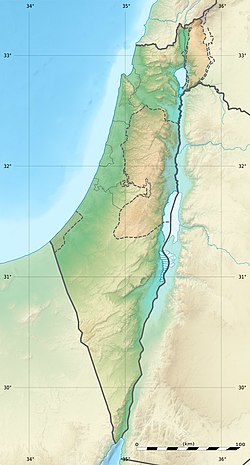Khirbet a-Ra'i
This article needs additional citations for verification. (March 2020) |
ח'ירבת א-ראעי | |
 Shown within Israel | |
| Region | Shfela |
|---|---|
| Coordinates | 31°35′27.6″N 34°49′09.4″E / 31.591000°N 34.819278°ECoordinates: 31°35′27.6″N 34°49′09.4″E / 31.591000°N 34.819278°E |
| History | |
| Periods | Bronze Age, Iron Age, Persian period, Hellenistic period, Byzantine period, Early Arab period, Ottoman period. |
| Cultures | Canaanite, Philistine |
| Site notes | |
| Archaeologists | Yosef Garfinkel and Saar Ganor |
Khirbet ar-Ra'i is an archaeological site in the Shephelah region of Israel. It is located some 3 km northwest of Tel Lachish on a hill on the Lachish River's southern bank. Based on the archeological findings, including the architecture and the pottery, Khirbat er-Ra‘i was mainly a Canaanite site, but with a strong Philistine influence.[1]
Location[]
Khirbet a-Ra'i has an area of about 17 dunams and is located between the upper and lower parts of the Shfela. It provides an excellent view towards the coastal region in the west, the Mount Hebron and Jerusalem in the east and Tell ej-Judeideh and Maresha to the north. The site controls the main road connecting the Coastal plain with the Shephelah and the Judea. These features make the site suitable to serve as a forward outpost of the settlements in the area of Lachish.[2]
Discovery & Excavations[]
The site has been surveyed by the PEF Survey of Palestine in 1875 and by Yehudah Dagan in 1992. It was first excavated in October 2015 and April 2016 on behalf of the Institute of Archaeology at The Hebrew University of Jerusalem and the Israel Antiquities Authority and under the direction of by Yosef Garfinkel and Saar Ganor. Two excavation areas (A and B) were opened were the remains of structures could be seen on the surface. The excavation revealed the ruins of a massive structure dating to the Iron Age I–II and fences from the Ottoman period. Other periods were represented in potsherds from the Middle Bronze Age, Persian, Hellenistic, Byzantine and the Early Islamic Period.
Archaeological Findings[]
In 2021, archaeologists Garfinkel and Ganor announced the discovery of a proto-Canaanite inscription dating to the 12th century BCE in Khirbet ar-Ra'i, a time period seen by many as the historical setting for the Biblical Book of Judges. The inscription, found on a jar, was deciphered by the epigrapher Prof. Christopher Rollston as bearing the name Jerubbaal, a name that appears only once in the Hebrew Bible as another name for the judge Gideon. According to the archaeologists, this inscription may refer to another Jerubbaal and not the Gideon of biblical tradition, but the fact that an identical name is found in archaeological site dating to a period identified with that of the Judges, shows that even though the Hebrew Bible was compiled in a much later period, some historical memories were preserved and passed down through the generations.[1]
Hebrew University epigrapher Dr. Haggai Misgav said that because the inscription is partial, he is not convinced that "Jerubbaal" is the only possible reading. The first seen letter, claimed to be yodh, could also be zayin. Maybe there's an ayin before that, so the inscription can refer to "Azruba'al" as well.[3]
See also[]
References[]
- ^ a b "3,000-year-old inscription bearing name of biblical judge found in Israel". The Jerusalem Post | JPost.com. Retrieved 2021-12-12.
- ^ Yossi Garfinkel and Sa‘ar Ganor (21 February 2017). "Khirbat er-Raʽi: Preliminary Report". Hadashot Arkheologiyot: Excavations and Surveys in Israel. Israel Antiquities Authority. 129.
- ^ Amanda Borschel-Dan. "Five-letter inscription inked 3,100 years ago may be name of biblical judge". www.timesofisrael.com. Retrieved 2021-12-13.
- Archaeological sites in Israel
- Bronze Age sites in Israel
- Iron Age sites in Israel
- Disputed Biblical places
- Canaanite cities
- Canaanite inscriptions
